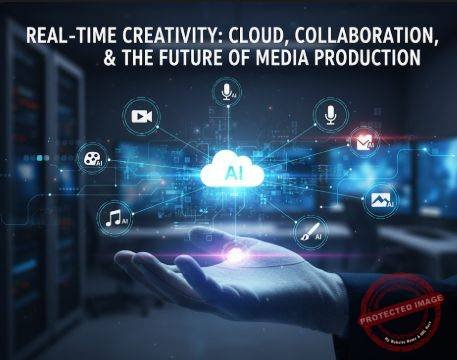How Cloud Platforms, AI, and Edge Processing Are Enabling Global, Real-Time Collaboration in the Creative Industries.
Creativity Without Boundaries
The modern creative landscape has transcended the limits of geography, hardware, and traditional production cycles. Artists, editors, animators, and producers no longer need to share the same studio space—or even the same continent—to create together.
Thanks to advances in cloud computing, real-time collaboration platforms, and AI-powered workflows, media production has entered an era of instant, global creativity.
From streaming studios to virtual film sets, teams are now co-creating in real time, transforming the way ideas move from concept to screen.
The result: a creative process that’s faster, smarter, and truly borderless.
Cloud as the Creative Backbone
At the heart of this new production paradigm lies the cloud—an infrastructure that provides the speed, scale, and accessibility required for modern content creation.
Cloud platforms like AWS Media Services, Google Cloud Media Studio, and Microsoft Azure Render Farm now host everything from raw footage to 3D assets, enabling:
-
Instant access to projects from anywhere in the world.
-
Centralized storage and version control, eliminating file confusion.
-
Real-time rendering and collaboration across multiple users.
-
Elastic scalability, so studios only pay for the power they use.
The cloud has turned creative production into a living workspace, connecting artists and engineers in seamless digital environments.
Real-Time Collaboration: Creativity at the Speed of Thought
The next big leap in production is happening through real-time collaboration tools that allow creators to build, edit, and review simultaneously.
-
Frame.io, Blackmagic Cloud, and Avid Edit On Demand enable synchronized editing sessions across continents.
-
Figma for video, such as Runway ML and WeVideo, lets teams storyboard, animate, and render collaboratively.
-
Virtual production tools, like Unreal Engine and NVIDIA Omniverse, merge physical and digital sets in real time.
This eliminates the bottlenecks of sequential editing and accelerates creative decision-making—allowing teams to create together, instantly.
AI and Automation in Production Workflows
AI is becoming the silent co-pilot in every stage of content creation. From asset management to editing automation, machine learning is optimizing creative pipelines with unprecedented efficiency.
-
AI-powered asset tagging automatically categorizes footage, graphics, and sound libraries.
-
Intelligent editing assistants identify best takes, sync dialogue, and balance color.
-
AI audio tools eliminate background noise and generate adaptive soundscapes.
-
Machine learning-driven rendering speeds up visual effects production.
These innovations free creators from repetitive tasks and let them focus on the art, not the process.
Edge Computing: Speed Meets Intelligence
In real-time production, latency is the enemy. That’s why edge computing—processing data closer to where it’s captured—is redefining performance standards.
-
5G-enabled cameras can stream directly to cloud editing suites.
-
Edge render nodes reduce lag in collaborative animation and visual effects.
-
Distributed compute clusters handle massive video workloads without delay.
By combining edge and cloud architectures, creative teams can achieve cinematic-grade results in real time—from live sports broadcasts to virtual film shoots.
The Globalization of Creative Talent
With cloud and collaboration tools, geography no longer dictates opportunity. Studios now operate with distributed teams spanning every continent, tapping into global talent pools without relocation barriers.
A film can be shot in Los Angeles, edited in Mumbai, color-graded in Berlin, and scored in Montreal—all in real time.
This globalization of talent not only enhances diversity of ideas but also creates 24-hour creative cycles, where work continues seamlessly around the world.
Security, Rights, and Digital Trust
As cloud collaboration scales, so do concerns around data privacy, intellectual property, and content ownership.
To protect creative assets, studios are deploying:
-
Zero Trust architectures for access management.
-
Blockchain-based provenance systems to verify authorship.
-
End-to-end encryption for all media transfers.
-
AI-driven anomaly detection to prevent unauthorized access.
In the cloud era, security is creativity’s silent guardian—protecting both innovation and ownership.
The Future: Immersive, Real-Time Production Ecosystems
The next evolution of media production will be fully immersive, blending physical and virtual collaboration. Imagine creators working together in shared holographic spaces, manipulating digital environments with gestures and voice commands.
As AR, VR, and AI converge, real-time creativity will become multisensory, interactive, and limitless—transforming production from a linear process into a living experience.
Closing Thoughts and Looking Forward
Cloud-based collaboration has redefined what’s possible in creative production. The combination of AI intelligence, real-time data processing, and global connectivity has transformed media creation into a dynamic, collective act of imagination.
The future of content creation will not belong to the biggest studios—but to the most connected, agile, and collaborative creators.
In this new creative era, inspiration moves at the speed of the cloud—and the world creates together.
References
-
“Real-Time Collaboration in Media Production” – World Economic Forum
https://www.weforum.org/agenda/2024/09/real-time-collaboration-in-media-production -
“Cloud and AI in Next-Gen Content Creation” – McKinsey & Company
https://www.mckinsey.com/industries/media-and-entertainment/our-insights/cloud-and-ai-in-next-gen-content-creation -
“Edge Computing and the Future of Real-Time Rendering” – MIT Technology Review
https://www.technologyreview.com/2024/10/09/edge-computing-and-real-time-rendering -
“Security and Collaboration in Cloud-Based Media” – Deloitte Insights
https://www.deloitte.com/insights/security-and-collaboration-in-cloud-based-media -
“The Globalization of Creative Workforces” – Forbes Tech Council
https://www.forbes.com/sites/forbestechcouncil/2024/09/30/the-globalization-of-creative-workforces
Author: Serge Boudreaux – AI Hardware Technologies, Montreal, Quebec
Co-Editor: Peter Jonathan Wilcheck – Miami, Florida
#AI #CloudComputing #Collaboration #ContentCreation #EdgeComputing #DigitalMedia #Automation #5G #Innovation #TechNews
Post Disclaimer
The information provided in our posts or blogs are for educational and informative purposes only. We do not guarantee the accuracy, completeness or suitability of the information. We do not provide financial or investment advice. Readers should always seek professional advice before making any financial or investment decisions based on the information provided in our content. We will not be held responsible for any losses, damages or consequences that may arise from relying on the information provided in our content.



